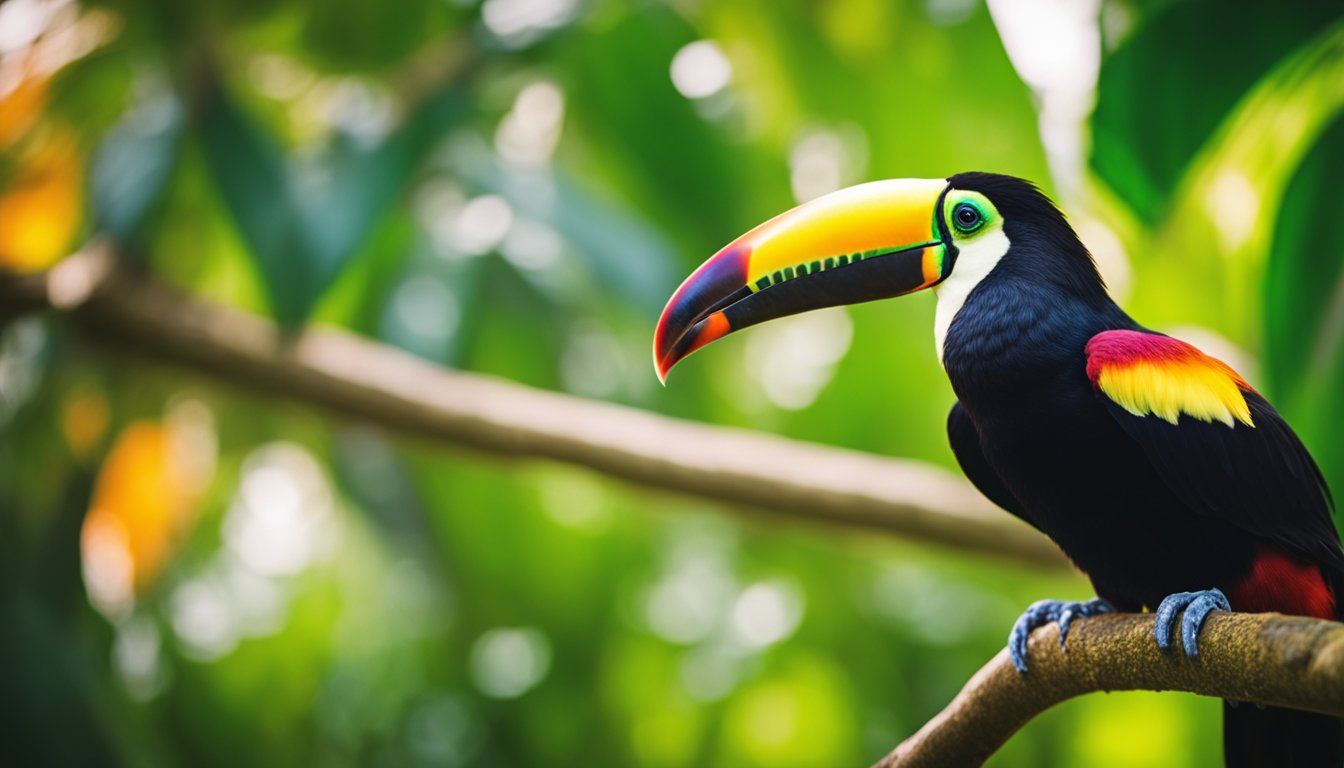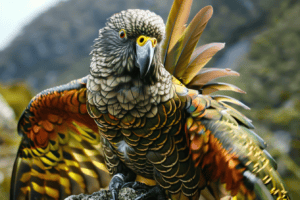Imagine us walking through the dense, green rainforest, where the sun peeks through the leaves, and there, perched on a branch, we see the star of our story: the toucan.
With its strikingly colorful bill, which looks like it was painted by a rainbow itself, this bird is one of the most recognizable creatures in the world.
We often spot these charismatic birds hopping through trees with a playful energy that’s as vibrant as their famous beaks.

Toucans are not just about bright beaks and beautiful feathers; they lead fascinating lives in the treetops.
Our feathered friends are not shy about showing off their large bills, which, while they may look heavy, are surprisingly light due to a network of air pockets inside.
These bills are their best tool for picking fruit, their favorite treat, and even for playfully tossing berries to each other!
Isn’t that a fruity game of catch?
As we explore more about these amazing birds, we’ll discover how their lives are closely intertwined with the forest around them.
Did you know that toucans play a critical role in planting new trees?
That’s right, by eating fruit and spreading seeds, they’re like the gardeners of the forest!
Let’s flap our wings and dive into the world of toucans together, to learn all about their habits, their homes, and just why that beak is so incredibly cool.
The Colorful World of Toucans

In the lush rainforests, we find toucans, celebrated for their vibrant beaks and lively plumage.
Together, let’s explore the kaleidoscope of colors that define these charming birds.
The Rainbow Beak
Have you ever wondered why toucans have such colorful beaks? Their beaks are not just for show; they play a critical role in their survival.
The beak of a toucan is a dazzling array of colors, including red, blue, orange, green, and yellow.
Imagine having a tool that helps you reach delicious fruits other birds can’t get to—toucans use their long beaks for just that!
Beyond foraging, these impressive beaks also help toucans regulate their body temperature.
The beak is like a personal air-conditioner on a hot day; blood flow to the beak increases to release heat and cool down our feathered friends.
Feathers and Flight
Toucans are not just about their iconic beaks; their feathers are equally fantastic.
The body feathers of a toucan are mostly black with touches of white, yellow, and sometimes red.
It’s as if they’re wearing a sleek, dark suit with a bright scarf!
This coloration helps them blend into the shadows of the canopy while the brighter colors provide a stunning contrast.
While they aren’t known for long-distance flights, toucans are skilled in short, swift flights within the trees.
Their flight is direct and undulating, enabling quick movement through their forest home.
We can learn that sometimes, it’s not about how far you travel but how effectively you can navigate your world.
Join us as we continue to celebrate the remarkable lives of these birds and discover more about their colorful existence.
Habitat and Diet

Before we explore the trees these colorful birds call home and the delicious fruits they feast on, let’s grab our binoculars and journey into the vibrant world of toucans.
Home Among the Trees
In the lush canopies of the tropical rainforest, we find our beaky friends perched high among the leafy branches.
These incredible birds favor the misty heights of Latin American jungles, from Mexico to Argentina.
Imagine us as miniature explorers, scampering across the great branches of towering trees like the fig and the ceiba—that’s exactly what toucans do every day!
Their homes are nestled in holes within the trees, which they often snatch from woodpeckers or repurpose after trees decay naturally.
Tropical Fruit Buffet
Now, imagine a buffet spread out as far as the eye can see, just for us—but it’s only filled with the juiciest tropical fruits!
That’s the diet of a toucan. They use their long, colorful beaks to pluck the tastiest treats like bananas, guavas, and mangoes.
Occasionally, we catch them snacking on insects, eggs, and even small lizards, but fruit is the star of the show.
In fact, by gobbling up fruits and pooping out the seeds later, toucans play a big part in spreading plants through the forest, making them amazing forest gardeners!
Isn’t it fascinating how toucans shape their world, just as we do ours?
By understanding their habitat and diet, we get a glimpse of the role these remarkable birds play in the tapestry of the rainforest.
Toucan Social Life

In the vibrant rainforests, we can often spot toucans socializing with their colorful beaks standing out like nature’s own masterpiece.
These birds are known for their communal behaviors, forming friendly flocks and communicating with a symphony of sounds.
Flocking Together
When it comes to hanging out, toucans sure love the company. They often gather in small groups called ‘flocks’.
Imagine them as a bunch of friends chatting away on the tree branches!
They aren’t just casual meetups; these flocks help toucans stay safe from predators, as there are many eyes to watch out for danger.
Plus, it’s much more fun for them to search for food together rather than doing it solo.
Fun Fact: Did you know that some toucan species like to play fruit catch? They toss berries to each other using their beaks!
Chirps and Calls
Now, let’s talk about how they communicate. Toucans are real chatterboxes of the bird world.
They have an assortment of calls ranging from croaks to squawks.
Each call has its unique purpose, whether it’s flirting, warning of danger, or just saying ‘hey’ to one another.
It’s like they have their secret language, and their oversized beaks work like nature’s megaphones amplifying these sounds throughout the forest.
Listen closely next time you’re in the forest; you might just hear the distinctive call of a toucan echoing through the trees!
Conservation Efforts

As we look closer at the colorful world of toucans, we find that their survival is under threat, but with our help, these birds with the rainbow beaks can continue to thrive.
Let’s explore the challenges they face and the steps we’re taking to safeguard their future.
Threats to Toucans
Would you believe it if I told you that some of the most vibrant birds in our skies are in danger? It’s a sad truth that toucans face.
The main dangers to these feathered friends are habitat loss and illegal pet trade.
Forests where toucans live are being cut down to make room for farms and cities.
Also, because toucans are so exotic, some people illegally catch them to sell as pets, which is a big no-no for their well-being.
Protecting the Rainbow
So, how do we keep the colors of the toucan’s world alive? There’s a lot that we’re doing!
We’re creating protected areas where toucans can live without the worry of losing their home.
This means making sure that the big, beautiful trees they love so much stay standing.
Plus, we raise awareness and work with local communities to show everyone how important it is to look after these birds.
After all, who would want to imagine a world without those bright beaks brightening up the sky? Not us! And let’s not forget about laws.
We’ve got some pretty strong rules in place to prevent people from selling toucans as pets.
Getting involved in conservation can feel like a grand adventure.
Imagine trekking through lush jungles, binoculars in hand, watching for that flash of color as a toucan darts by.
By understanding the problems and taking action, together we can make sure future generations get to experience that same sense of wonder.
Frequently Asked Questions
In the colorful world of toucans, there’s so much for us to explore together!
Let’s dive into some of the most curious questions we’ve ever wondered about these rainbow-beaked wonders.
What marvelous features allow toucans to adapt to their environment?
Toucans are a true marvel of adaptation. Their oversized, vibrant beaks aren’t just for show; they’re like nature’s toolkit.
The beak helps them reach fruit on branches that are too small to support their weight and serves as a personal air conditioning unit to regulate their body temperature.
Their zygodactyl feet, with two toes facing forward and two backward, make them excellent climbers to navigate the treetops where they dwell.
How do these vibrant-beaked friends help their ecosystem thrive?
Our beaky buddies are like the gardeners of the rainforest.
By eating fruits and flying long distances, they scatter seeds far and wide which helps new plants grow.
This seed dispersal is crucial for the health of their home, ensuring that their tropical paradise stays lush and full of life.
What’s the scoop on the lifestyle of toucans, from their favorite snacks to their tree-top homes?
Toucans love to feast on a buffet of fruits, insects, and small animals—they aren’t picky eaters!
They prefer to live high up in the canopy in nests that are holes in trees, which keeps them safe from predators.
Sometimes they even move into nests vacated by woodpeckers or other birds, proving that they’re resourceful homemakers.
Could you imagine life as a toucan? What’s their daily routine like from sunrise to sunset?
Let’s picture our day as a toucan. We’d wake up at sunrise and sing a little to signal a new day.
Then, it’s breakfast time—likely a nutritious fruit we’d find nearby.
Throughout the day, we’d hop and fly from tree to tree, socializing with others, and yes, more eating!
As the sun sets, we’d retreat to the safety of our tree-hole homes for a good night’s sleep, ready to start it all over again.
Ever wondered how long toucans can share our world with us?
Toucans can live quite a while, with many of them hanging out in the rainforest for up to 20 years!
This is, of course, if their homes are kept safe and they’re not threatened by things like habitat loss or illegal pet trade.
It’s our job to make sure these beautiful birds keep chirping for years to come.
Are toucans solo performers or do they have a penchant for forming tuneful choruses?
Despite their showy appearance, toucans are quite social and enjoy the company of their flock, known as a “band.” They don’t sing much, but when they do make noise, it’s an array of croaks and rattles that sound like a frog concert.
They’re definitely known for being part of the rainforest’s daily symphony.









